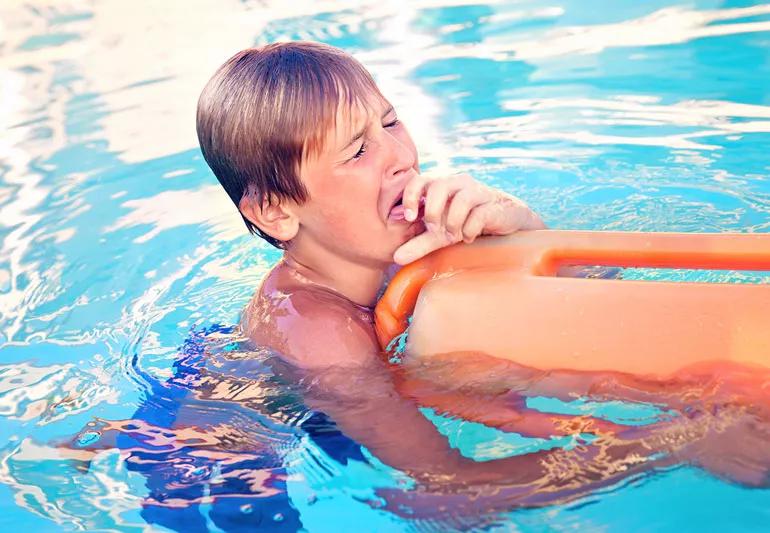Dry drowning is an airway closure from choking on water without getting fluid in your lungs

Drowning is defined as a respiratory impairment — that is, being unable to breathe — because you’ve been submerged in water.
Advertisement
Cleveland Clinic is a non-profit academic medical center. Advertising on our site helps support our mission. We do not endorse non-Cleveland Clinic products or services. Policy
But maybe at some point, you’ve come across articles or social media posts discussing something called dry drowning. Or maybe you’ve seen a passing reference to a term called secondary drowning.
Unsurprisingly, these terms might’ve scared you. After all, the idea of drowning during a swim in a pool or lake is terrifying enough. Do you also have to worry about the risks of drowning outside of the water?
Thankfully, dry drowning, as well as secondary drowning, isn’t quite what you think it means.
For starters, “‘dry drowning’ is not a real medical term,” says pediatric emergency medicine doctor Purva Grover, MD.
But you can be seriously injured if you survive a near-drowning experience, especially if you have a water incident where you can’t breathe or you get water in your lungs.
Dr. Grover and emergency medicine doctor Jason Milk, DO, explain what these terms mean, when to be worried and what symptoms to look out for.
Learn the warning signs of dry drowning.
All drowning events require exposure to water, which is why doctors shy away from using the term “dry drowning.” (After all, it sounds silly to say, “wet drowning,” right?)
“You need the water as a starter, just like I need a match to start a fire,” notes Dr. Milk.
Advertisement
But the concept of dry drowning emerged to explain what happens during certain drowning experiences.
When you’re struggling underwater and unable to come up for air, you experience a reflex called a laryngeal spasm. This spasm shuts off your airway, meaning you can no longer breathe.
When this airway closure happens and no water goes into your lungs, that’s technically dry drowning, explains Dr. Milk. “The injury happens from a lack of air and asphyxiation.”
What people refer to as secondary drowning is better described as a secondary injury from a near-drowning. This injury most often happens when water gets into your airway.
For example, inhaling water before your airway clamps shut from a laryngeal spasm can be a big concern. Too much water can cause lung damage and breathing problems that become serious six to 12 hours later.
One of the most serious conditions that you can get from ingesting water into your lungs is pulmonary edema. That’s when fluid starts accumulating in your lungs, causing swelling. “Your lungs stop functioning correctly — and this can be a serious medical emergency,” says Dr. Milk.
Pulmonary edema causes you to have trouble breathing or experience frightening sensations like shortness of breath and chest tightness. “Liquid, or fluid, is actually in your airway,” he continues. “You’re kind of drowning in your own fluid, even though you’re not in the water.”
The signs and symptoms of dry drowning are the same as the ones you experience when drowning.
So, if you come up spluttering after a cannonball, you’re not necessarily at risk of suddenly drowning the next day.
“However, if you do have a near-drowning incident, symptoms can show up after you’ve left the water,” Dr. Grover says.
In other words, you’ll cough a lot and may think that any water you inhaled is gone — but 12 hours later, you might start to experience breathing problems because your lungs are swelling from water.
This delayed reaction is why if you were struggling underwater and unable to breathe, you should get checked out by a medical expert to make sure your lungs are clear and undamaged.
But you’ll likely know if something is wrong soon after you leave the water, as the signs of pulmonary edema emerge quickly.
If you experience any of these warning signs after a water incident, or sense that something isn’t right, see a doctor. Early symptoms include:
More serious symptoms point to an infection or vascular breakdown. These signs include:
Advertisement
The progression of these symptoms depends on your exposure to water. “Some people will progress to the coughing and the mild shortness of breath phase and never go farther,” Dr. Milk states. “Some people will start there and progress further.”
The symptom progression — and symptoms that emerge — depend on your personal health history, he adds. “If you have your history of asthma or lung disease, if you’re older and have a smoking history, you may be more susceptible to go down that pathway faster by comparison to somebody else.”
“If you’ve had exposure to water and it’s a near-drowning and you develop these symptoms later after seeming to be OK, these are significant warning signs and you should be seen,” stresses Dr. Milk.
People who were submerged underwater, especially kids, should be examined and monitored by a physician, Dr. Grover adds. “As a mother and an ER physician, I say better safe than sorry.”
Dry drowning may not be a medical term, but you should take any near-drowning incident seriously, Dr. Grover says.
Tragically, drowning and near-drowning events are leading causes of death in children. And you can drown in just a few minutes, even in water as shallow as an inch.
How can you prevent these tragic incidents?
Advertisement
At the end of the day, if you or your kiddo inhaled some water while swimming or got dunked in the pool during water tag, there’s no need to worry, Dr. Grover reassures. But drowning and near-drowning are always a concern — meaning you can never be too safe by the water.
Advertisement
Learn more about our editorial process.
Advertisement

Changing how you breathe, gargling water and distracting yourself are all common ways to stop your diaphragm from spasming

Simple at-home solutions, like doing pursed lip breathing and drinking a warm beverage, can often bring immediate relief

Mouth taping may seem promising, but it can actually cause more harm than good, especially if you snore or have sleep apnea

When something like food or drink goes down your windpipe rather than your esophagus, it can cause coughing and sometimes choking

Getting vaccinated in October can help protect you against severe illness between November and March

Breathing through your nose is far better for you, but depending on your anatomy, that may not always be possible

One theory is brain temperature regulation, and yes, a ‘contagious yawn’ is a real thing

This style of breathwork can invigorate you and help you focus

The best parenting style balances enforcing rules and showing plenty of love

Tips include cutting back on sugar, focusing on exercise and managing stress

It can be harder to let go when you’ve invested time, energy and emotions — but it might be the healthier choice long term